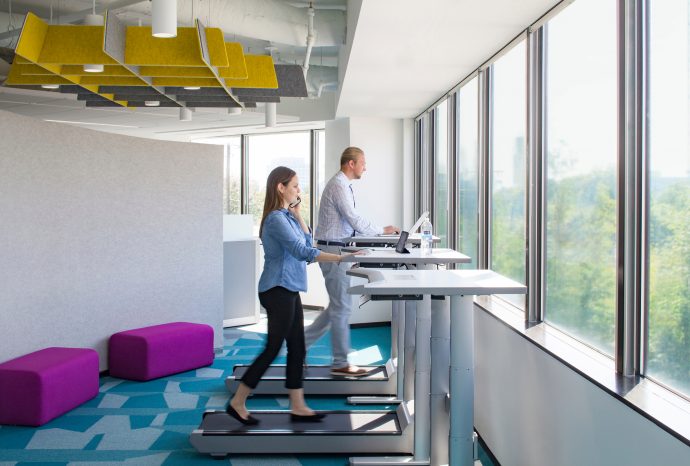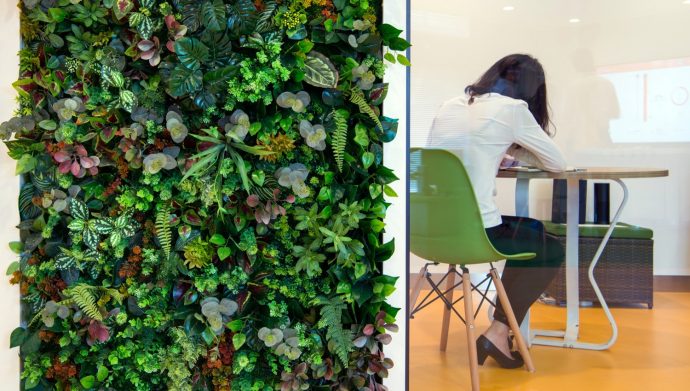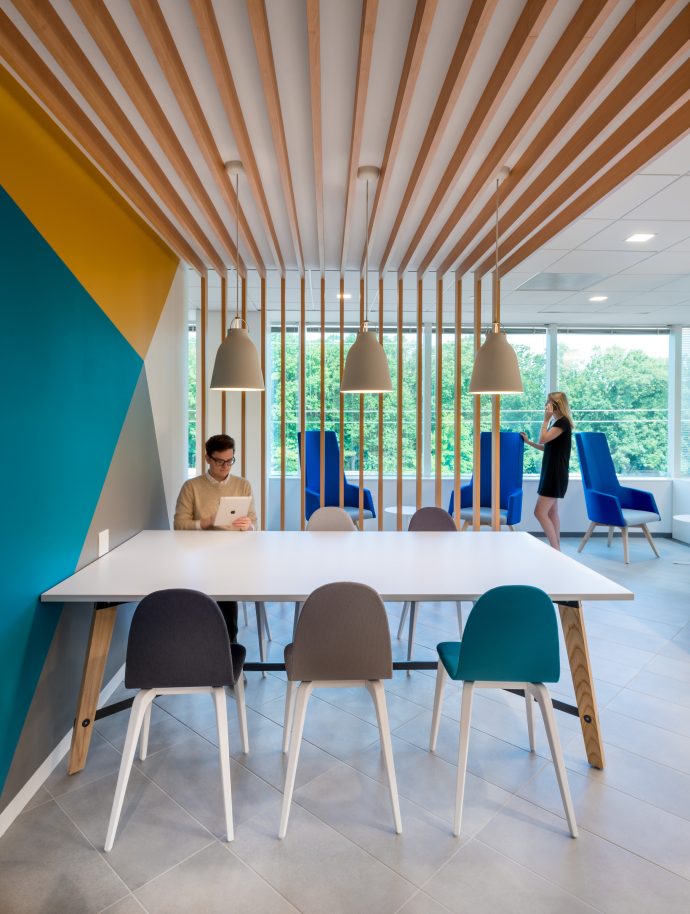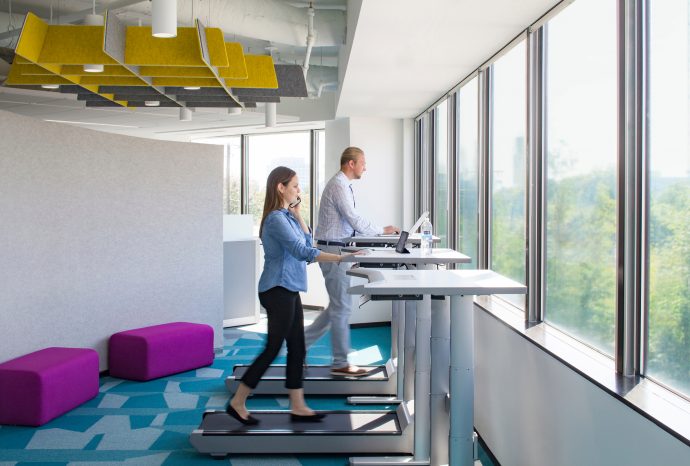Joelle Jach, Workplace Strategist at CallisonRTKL, explores how organizations can use WELL building standards as a guideline for understanding the impacts of the built environment on human health and well-being.

An Inside Job
As architects, designers, and workplace strategists, we’re always thinking about how to best design the interior work environment to fit occupant needs – and since we spend about 90 percent of our time indoors, we have an opportunity to benefit occupants through design and operations.
LEEDing the Way
LEED (Leadership in Energy and Environmental Design) has long been the basis of green design and energy efficiency in the US, encompassing design elements, building performance, and sustainable operations. However, with increased client interest in wellness and well-being, there is potential for buildings to address aspects of sustainability beyond energy efficiency.
LEED and comparable systems focus on aspects of the built environment, but until recently, few standards addressed the human impacts of design. The WELL building standard, first published in 2014[1], was the first major building certification and rating system to consider the built environment through the lens of human health. The system is now in use around the world, and encompasses ways to design, build and operate for the benefit of human occupants.
WELL is made up of seven concepts, each of which includes individual features that can shape a project. Some concepts, like Air and Water, address goals similar to those set out in LEED. Beyond energy efficiency and building performance, however, WELL builds on LEED’s goals to include concepts like Comfort and Mind, which target workplace aspects like acoustics, ergonomics, stress reduction, and mental health. Incorporating these considerations into design, construction, and operations can have measurable benefits on occupant health, and demonstrating a commitment to human well-being can positively impact an organization’s bottom line.
Why Wellness Matters
From formalized wellness programs to the provision of sit-to-stand desks, some wellness interventions have already become popular in many workplaces, but there is still a need for organizations to understand the benefits of workplace well-being. Incorporating energy efficiency into workplace design can decrease facility costs, and promoting employee productivity and engagement can increase employee attraction and retention. By understanding the connection between humans and their environment, and by providing an environment that supports human needs, organizations can target cost savings as well as an engaged workforce.

Wellness: Issues, Impacts and Implementations
Air, IAQ and Temperature
Indoor air quality (IAQ) is closely connected to respiratory health and cognition capabilities. Pollutants and unwanted contaminants in indoor air can make it difficult to breathe, let alone think and work effectively. Airborne germs and materials off-gassing can irritate asthma, allergies and illness, posing a threat to physical health. Selection of easy-to-clean and low-emitting materials can contribute to IAQ and promote clean indoor air.[2]
Increasing air exchange rates and decreasing concentrations of CO2 (carbon dioxide) and VOCs (volatile organic compounds) can benefit skills like preparation, strategizing and decision-making[3] – many of the abilities associated with productivity at work. Temperature can also influence effectiveness at work – an environment that is too hot or too cold can measurably decrease productivity.[4] Providing adjustability wherever possible can enhance employee comfort and promote engagement.
Physical Activity and Ergonomics
While prolonged sitting can contribute to physical problems, decreased cognitive function and productivity[5], prolonged standing also puts employees at risk for physical problems.[6] Physical posture can also affect our moods and stress levels, which can spell bad news for an already stressed-out workforce.
Taking a break every 30 to 60 minutes is a good way to prevent some of the risks associated with stationary work,[7] and active design can help to introduce movement into the workplace. Promoting stair usage and emphasizing circulation space can promote physical activity and social interaction within the workplace,[8] and strategies like activity-based working provide flexibility, choice and control in the work environment.
No matter where work takes place, individual workspaces should be ergonomic and supportive. An ergonomic work environment can bring return on investment for organizations, and proper ergonomics can prevent instances of musculoskeletal disorders, pain and injury.[9] Investing in ergonomic furniture and equipment, as well as training and education, can empower, support and engage employees[10] within the work environment.
Noise and Acoustics
Performance and productivity can decrease by up to 66% with excess background noise[11], and conversations cause most of the noise distraction in the office. Noise can have non-auditory effects as well: too much noise can cause feelings of exposure and can trigger stress responses, including raised blood pressure.[12] Even low levels of background noise can negatively impact sleep[13] and cause psychological disengagement as well as decreased cognitive function.[14]
Even in an open environment, lower cubicle walls can increase awareness of noise and decrease noise levels.[15] Sound masking can make conversations less discernible and less distracting, and acoustical materials and sound barriers can decrease sound transmission across spaces, leading to lower overall noise levels in the workplace.
Zoning spaces according to noise level can limit noise distractions and allow for focus and concentration in individual workspaces. Social dynamics and behaviors can also go a long way towards promoting considerate behaviors (i.e., no speakerphone usage at the desk) and establishing norms around noise levels.
Lighting and Daylight
Even though we spend so much of our time indoors, natural light helps to synchronize circadian rhythms, impacting alertness, sleep quality, stress levels and risk for depression.[16] Access to natural light contributes to workplace satisfaction, task performance, and productivity gains,[17] and can contribute to decreased absenteeism in the workplace.[18]
Beyond just natural light, it’s important to consider the overall light level within a workplace. Insufficient indoor light levels can contribute to physical problems (eyestrain, headaches), decreased productivity, and feelings of frustration on the job.[19] Light level requirements vary by worker as well as by task – paper-based tasks require a different amount and type of lighting than do computer-based tasks, and workers of different ages may have different contrast requirements. Providing appropriate levels of lighting is a good way to promote visual acuity and productivity, [20] and task lighting is can provide adjustability.

Stress and Mental Health
There’s no way around it: most of us are stressed out on the job. Stress impacts aspects of life outside of the workplace, including sleep, interpersonal relationships, diet and exercise, and high stress levels can increase the risk for stroke and cardiac disease.[21] Even vacation time isn’t necessarily the answer – a shocking amount of vacation days go unused in the U.S. every year.[22]
Open-office environments can cause feelings of exposure, leading to increased stress responses and withdrawal,[23] so areas of respite are beneficial for restoring energy and focus. Social interaction is also an important part of the workplace, and increased flexibility through technology is causing organizations to consider the impact of telework on employees who are still in the office.[24]
While technology has allowed us to be more flexible and mobile, it’s also blurred the lines between working hours and non-working hours, causing many employees to virtually work around the clock. Competition in the workplace can contribute to higher levels of stress, more guilt at taking time off, and a more negative culture,[25] all of which can lead to feelings of burnout.
In addition to mitigating the sources of workplace stress, it’s never a bad idea to incorporate stress-relief and stress-management techniques into the workplace. Everything from workplace yoga to meditation can make a difference in stress levels in the workplace, and promoting work-life balance wherever possible can increase employee engagement and retention.

Bottom-Line Impacts
While a healthy workplace sounds like a good thing, it’s sometimes difficult to make the case for workplace well-being without tying it back to business performance. Research demonstrates a correlation between supporting employee well-being and bottom-line savings, where targeting environmental aspects like air quality, ventilation, lighting and acoustics can contribute to higher productivity, less absenteeism, and even higher levels of employee satisfaction.[26] Considering environmental aspects and supporting employees’ physical and mental health show that an organization is committed to its people, which can boost attraction, engagement and retention.[27]
In the “war for talent,” organizations seek to attract the best and brightest. While a perk like a Ping Pong table may grab attention, a focus on engagement and retention can prove to be more beneficial for organizations in the long run. When it comes to employee attraction, a commitment to wellness can be a big differentiator[28] – but even a formalized wellness program may not be a cure-all. Wellness programs should be offered within the larger scope of organizational initiatives to promote employees’ mental and physical health.[29] Prioritizing employee health and well-being in the workplace should come as part of the organizational culture, allowing organizations to realize financial and personnel benefits.
Where WELL Comes In
There are plenty of issues impacting employee health in the workplace, but there is also an opportunity to benefit employees through design and operations. In much the same way as designing for LEED certification, considering the WELL building standard can help drive the design for maximum occupant benefit.
WELL is made up of seven concepts, addresses everything from architectural elements to organizational policies to target human health, and achievement of a WELL certification means that a project considers various elements of the workplace through the lens of employee well-being.
While WELL is still a relatively new system, its impact is expected to grow as more organizations express interest in workplace well-being. Wellness strategies will vary across clients and across workplaces, and there are many different considerations when it comes to impacting occupant well-being. WELL serves as a cohesive guideline for understanding the impacts of the built environment on human health and well-being, and is an excellent resource for the development and implementation of impactful wellness strategies in the workplace. Even without pursuing formal certification, projects can use WELL as an evidence-based framework for targeting wellness-based design strategies.
[1] IWBI. “About Us.” International Well Building Institute, 2017. Retrieved from: https://www.wellcertified.com/about-iwbi.
[2] Budds, Diana. “It’s Time to Put Buildings on a Diet.” Fast Company, 20 May 2016.
[3] Allen, Joseph G. “Research: Stale Office Air is Making You Less Productive.” Harvard Business Review, 21 March 2017.
[4] Sneed, Annie. “The Air in Your Office is Making You Bad at Your Job.” Fast Company, 2 December 2015.
[5] Stringer, Leigh, on behalf of Kare, Shweta. “10 Bad Habits That Should be Banned from the Workplace Forever.” CareerBright, 23 October 2016.
[6] Izadi, Elahe. “Sitting for long periods doesn’t make death more imminent, study suggests.” The Washington Post, 14 October 2015.
[7] Bean, Sara. “Too much focus on standing in the sit-stand debate, say ergonomics experts.” Workplace Insight, 2 December 2015.
[8] Morrison, Grant, Boucher, Bernice, and Alldridge, Trevor. “Fully Engaged.” Jones Lang LaSalle, 2016.
[9] Hedge, Alan. “The Economics of Ergonomics: A History of Working Success.” HR Voice, 31 October 2016.
[10] Winston, Anna. “Ergonomics not evolving quickly enough for the modern workplace, says Haworth.” Dezeen, 11 August 2016.
[11] Moffat, Sophy, and Troni, Elisabeth. “Well Workplace: Making Spaces Human Again.” Cushman & Wakefield, 2017.
[12] “Too Much Noise.” Steelcase, 2017.
[13] Hester, Jessica Leigh. “When it Comes to Workplace Noise, Millennials Can’t Even.” Citylab, 16 June 2016.
[14] Skerrett, Patrick J. “Noise at the Office: How to Cope,” Harvard Business Review, 2010.
[15] Noguchi, Yuki. “What’s More Distracting Than a Noisy Coworker? Turns Out, Not Much.” National Public Radio, 26 October 2016.
[16] Mullaney, Rebekah. “LRC Study Finds Robust Morning Light Improves Sleep and Mood, Lowers Stress in Office Workers.” Lighting Research Center, 22 May 2017.
[17] Sargent, Katie. “Is Sitting at Work Killing Your Creative Mojo?” Work Design Magazine, 30 October 2015.
[18] Ford, Bob. “Harnessing the Power of Natural Light.” Work Design Magazine, 24 May 2017.
[19] Grasso, Natalie. “Biophilia and Your Workplace.” Work Design Magazine, 15 April 2016.
[20] Dilouie, Craig. “Personal Control: Boosting Productivity, Energy Savings.” Lighting Controls Association, 14 September 2004.
[21] Porter, Jane. “How Google and Others Help Employees Burn Off Stress in Unique Ways.” FastCompany, 16 November 2015.
[22] Strutner, Suzy. “You Won’t Believe How Many Vacation Days America Wasted Last Year.” The Huffington Post, 14 June 2016.
[23] Morrison, Rachel. “Open-plan offices might be making us less social and productive, not more.” Quartz, 19 September 2016.
[24] Korkki, Phyllis. “Telecommuting Can Make the Office a Lonely Place, a Study Says.” The New York Times, 2 January 2016.
[25] Gregoire, Carolyn. “The American Workplace is Broken. Here’s How We Can Start Fixing It.” The Huffington Post, 22 November 2016.
[26] Singh A, Syal M, Grady SC, and Korkmaz S. “Effects of Green Buildings on Employee Health and Productivity.” American Journal of Public Health, 10 December 2009.
[27] Garton, Eric, and Mankins, Michael. “Engaging Your Employees is Good, but Don’t Stop There.” Harvard Business Review, 9 December 2015.
[28] Bunch, Julia. “How Do You Prove a Workplace is Healthy, and Do We Need To?” Bisnow, 25 January 2017.
[29] Appleby, Julie. “Workplace Wellness Programs: Early Alarm for Workers’ Health or a Recipe for Over-Testing?” Kaiser Health News, 5 October 2015.



Thank you for sharing this wonderful article and knowledge. I will definitely share it to my interior designer and architect friends. This article is surely a big help for them!
Great article surely will be a huge help for interior designing. I will consider your points and share it to my friends and to our company management team.
[…] argues that comfort and wellbeing also have a direct impact on employee retention; we all want to work somewhere that’s nice to […]
does best design the interior work, completely environment to fit occupant needs
Designs are best.. focused on occupant needs, best design the interior work, completely environment
Big help for interior designing..Good Job